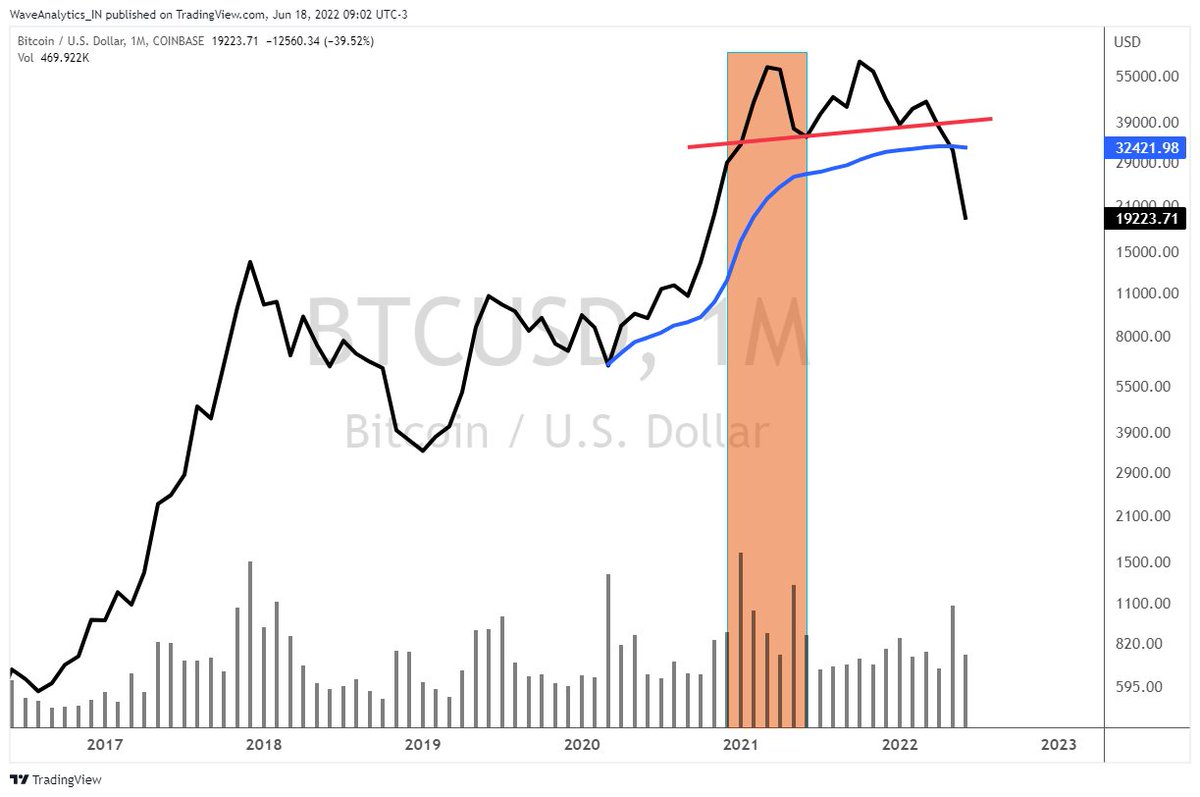I don't expect either to happen in 2021, but have to pay attention to these.
1/ The #Bitcoin bear case has two two components:
The macro, and the miners.
THREAD 👇
I don't expect either to happen in 2021, but have to pay attention to these.
=> the more capacity installed, the higher the difficulty, and the higher the cost.
These are the happy times.
Here's an old thread on that topic. Mind that the bitcoin produced a month is now 27,375, or about 900 a day. This quantity halved in May.
https://t.co/PPPtXM6hOB
1/ A thread on bitcoin mining game theory.
— Alex Kr\xfcger (@krugermacro) October 10, 2019
The Bitcoin network produces approximately 54,750 bitcoin a month in block rewards.
Every month. pic.twitter.com/l7Y6BElamT
That's why hashrate increases lag price increases.
This adds to reflexivity and helps prices further up.
Miners did hold inventories back late 2020, but their selling volumes have already increased in 2021, with price in the 30s-40s.
1800 bitcoin/day * $10,000 = $18,000,000/day
900 bitcoin/day * 35,000 = $31,500,000/day
@cryptoquant_com
@glassnode
@thetokenanalyst
All require a subscription unfortunately.
I mostly use CryptoQuant: https://t.co/AaOPJjxt7h
Their founder @ki_young_ju shares very useful data on Twitter.
More from Bitcoin
$BTC views
Price needs to let volatility wear off before its next big move. Thinking 30K-40K range for the next 1-2 weeks. Then either 50K straight or after piercing 30K and bouncing back above 30K within 1-2 days.
$27500-$27000 is the key area. If price heads back down to 30K, expect 30K to be breached, fall to that area, and bounce back. FAST. All very fast.

What do I do with this information?
Simple.
I'm trading the range against a core position. Buying when price pushes lower, selling when higher. It's like playing the achordeon. There's always air left inside.
Where exactly?
Nowhere.
I don't use limits for that. $BTC is liquid enough to trade at market without issues.
I'm watching PA, volume and rates for buying and euphoria as reflected in rates for reducing.
Decision making is dynamic. Nothing is set in stone. But most likely if price heads back down to 30K 'll be holding off next time. The gameplan is to have ammo to buy the dip (to redeploy). If 30K breaks absolutely no buying until down to 27Ks or back above 30K.
Price needs to let volatility wear off before its next big move. Thinking 30K-40K range for the next 1-2 weeks. Then either 50K straight or after piercing 30K and bouncing back above 30K within 1-2 days.
My $BTC short-term view after long deliberation and some flip flopping is rangebound in 30K-40K until the curve and vols come off a further. Then, 50K. I wouldn't be surprised if 30K is briefly breached but the risk is to the upside. Those calling for 20K missing the big picture.
— Alex (@classicmacro) January 12, 2021
$27500-$27000 is the key area. If price heads back down to 30K, expect 30K to be breached, fall to that area, and bounce back. FAST. All very fast.

What do I do with this information?
Simple.
I'm trading the range against a core position. Buying when price pushes lower, selling when higher. It's like playing the achordeon. There's always air left inside.
Where exactly?
Nowhere.
I don't use limits for that. $BTC is liquid enough to trade at market without issues.
I'm watching PA, volume and rates for buying and euphoria as reflected in rates for reducing.
Decision making is dynamic. Nothing is set in stone. But most likely if price heads back down to 30K 'll be holding off next time. The gameplan is to have ammo to buy the dip (to redeploy). If 30K breaks absolutely no buying until down to 27Ks or back above 30K.
You May Also Like
On the occasion of youtube 20k and Twitter 70k members
A small tribute/gift to members
Screeners
technical screeners - intraday and positional both
before proceeding - i have helped you , can i ask you so that it can help someone else too
thank you
positional one
run - find #stock - draw chart - find levels
1- Stocks closing daily 2% up from 5 days
https://t.co/gTZrYY3Nht
2- Weekly breakout
https://t.co/1f4ahEolYB
3- Breakouts in short term
https://t.co/BI4h0CdgO2
4- Bullish from last 5
intraday screeners
5- 15 minute Stock Breakouts
https://t.co/9eAo82iuNv
6- Intraday Buying seen in the past 15 minutes
https://t.co/XqAJKhLB5G
7- Stocks trading near day's high on 5 min chart with volume BO intraday
https://t.co/flHmm6QXmo
Thank you
A small tribute/gift to members
Screeners
technical screeners - intraday and positional both
before proceeding - i have helped you , can i ask you so that it can help someone else too
thank you
positional one
run - find #stock - draw chart - find levels
1- Stocks closing daily 2% up from 5 days
https://t.co/gTZrYY3Nht
2- Weekly breakout
https://t.co/1f4ahEolYB
3- Breakouts in short term
https://t.co/BI4h0CdgO2
4- Bullish from last 5
intraday screeners
5- 15 minute Stock Breakouts
https://t.co/9eAo82iuNv
6- Intraday Buying seen in the past 15 minutes
https://t.co/XqAJKhLB5G
7- Stocks trading near day's high on 5 min chart with volume BO intraday
https://t.co/flHmm6QXmo
Thank you























